NVIDIA GeForce GTX 680 Review: Retaking The Performance Crown
by Ryan Smith on March 22, 2012 9:00 AM ESTPower, Temperature, & Noise
As always, we’re wrapping up our look at a new video card’s stock performance with a look at power, temperature, and noise. With new process nodes being the lifeblood of the GPU industry, each new process gives GPU manufacturers a chance to move their product along a continuum; do they take advantage of a power consumption reduction for the same performance level, a performance increase for the same power consumption, or something in between? For NVIDIA the answer is a bit of “all of the above”, as while the GK104 based GTX 680 is more a direct successor of the GF114 based GTX 560 Ti in terms of how the GPU was built, NVIDIA has increased their power consumption while at the same time decreasing their die size relative to GF114.
| GeForce GTX 680 Voltages | ||||
| Ref GTX 680 Base Load | Ref GTX 680 Boost Load | Ref GTX 680 Idle | ||
| 1.062v | 1.175v | 0.987v | ||
As we noted in our look at GPU Boost, the operating voltage of the GTX 680 depends on the quality of the GPU and the clockspeed it runs at. The higher the clockspeed, the higher the operating voltage, starting from a typical voltage of 1.062v at the base clockspeed of 1006MHz, up to 1.175v at the peak clockspeed of our sample of 1110MHz. Idle voltages are far most consistent however, with the GTX 680 always dropping to 0.987v at idle.
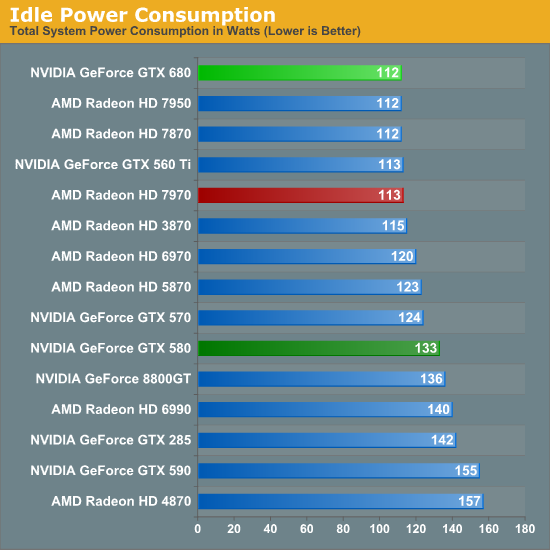
Speaking of idle, let’s start there. NVIDIA idle power consumption hasn’t significantly changed relative to GTX 560 Ti – not to say that NVIDIA hasn’t been working on this factor, but the low-hanging fruit has long been plucked. At 112W at the wall the GTX 680 is actually tied for the lowest power consumption among contemporary cards past and present, but with an estimated 15W idle TDP it’s not significantly different from any of those cards.
One interesting point though is that because GK104 is a GF114 derivative rather than a GF110 derivative, the GTX 680 does much better here compared to the GTX 580. We’re saving over 20W at the wall thanks to fewer RAM chips, less power regulation circuitry, and like most other things relating to GTX 680, a general increase in efficiency.
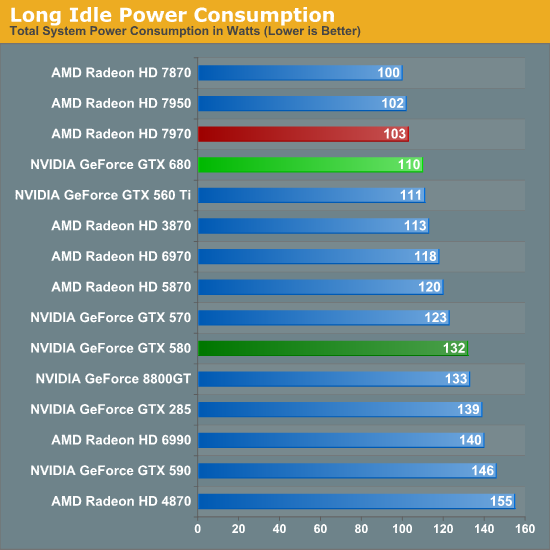
One thing NVIDIA specifically hasn’t touched though is the so-called “long idle” state where the system is powered up but the monitor is blank. GTX 680 shaves off a watt here versus GTX 560 Ti and 22W versus GTX 580, but without any special technology to further step down, they can’t match AMD and their ZeroCore Power technology.
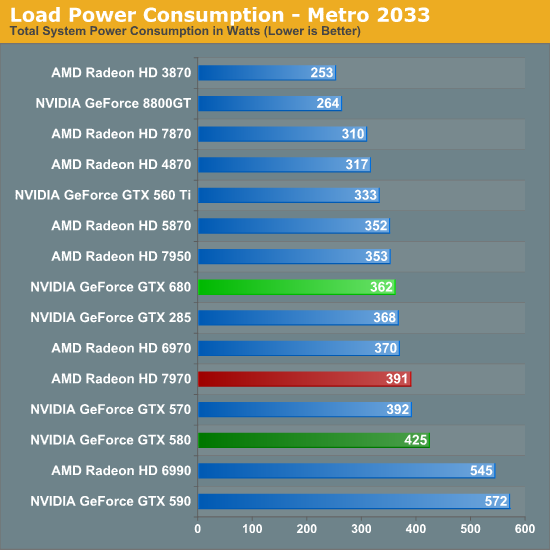
Shifting into load power consumption, our first measurement is from running our Metro 2033 benchmark. The results are roughly where we’d expect them, with the GTX 680 drawing more power than the GTX 560 Ti, but less power than the Radeon HD 7970, and compared to the GTX 580 significantly less power. Things are much closer compared to the 7950 however thanks to its similar 200W PowerTune limit, with the GTX 680 drawing only 9W more at the wall.
Because the performance of the video card here impacts the CPU load by requiring more frames to be prepared, power consumption does go up slightly with performance increases, which means some of the power consumption growth we’re seeing here relative to the GTX 560 Ti is a result of that performance gap, but measuring from the wall doesn’t let us fully separate it. NVIDIA’s power target GPU Boost on Metro 2033 is 170W, the same as the GTX 560 Ti’s TDP, but in all likelihood power consumption has jumped up at least 10W, while power consumption compared to the 7950 is probably a wash.
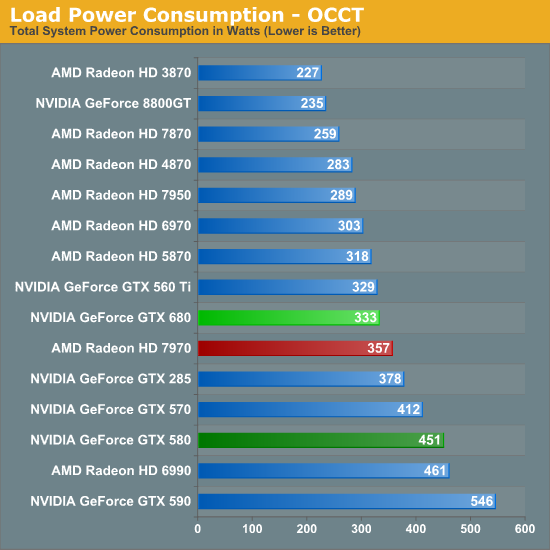
Our other power measurement is our pathological case with OCCT. In this case NVIDIA’s lack of a true throttling system continues to be to their disadvantage, as while AMD’s cards can cap their power consumption NVIDIA’s cards must keep going. In spite of this power consumption relative to the 7970 is still lower by 25W, but it blows past the 7950 by 44W. On the NVIDIA side of things though we can see just how much a smaller die and 28nm improve on matters compared to the GTX 580 – the 118W difference is nothing short of staggering. NVIDIA’s big GPUs can capture the performance crown, but they come with a high power cost, which makes taking the crown with the much smaller GK104 all the more important for NVIDIA.
On that note, it’s interesting to see that while power consumption runs high compared to AMD’s cards, compared to the GTX 560 Ti, power consumption has only ticked up by 4W. This reflects the fact that the GTX 680 is the successor to the GTX 560 Ti’s design, which means both cards have similar TDPs, though we would have actually expected the gap between the two to be wider. So in the worst case scenario NVIDA is exceeding our expectations.
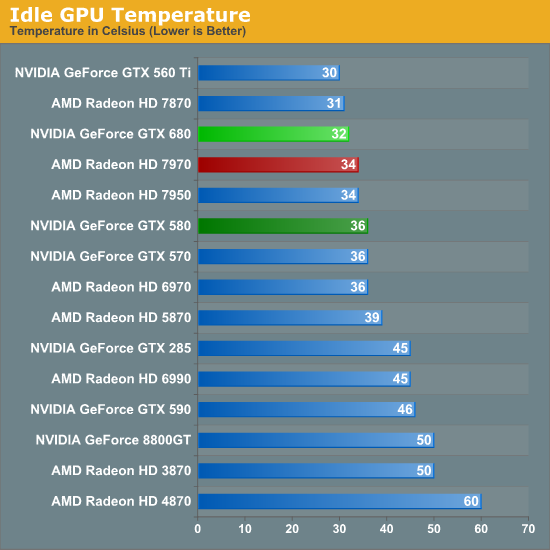
Moving past power consumption we have our look at temperatures, one of the two physical attributes that’s a derivative of power consumption. Idle temperatures aren’t too hard to do well at so long as your idle power consumption is solid and this is indeed the case for the GTX 680. The use of a blower means that NVIDIA can’t match the raw efficiency of the GTX 560 Ti, but they actually manage to edge out the Radeon HD 7900 series here. More to the point this continues what has been a long trend with regards to reducing idle temperatures; since the 8800GT the idle temperatures of NVIDIA’s top GPUs have dropped from a toasty 50C to 32C.
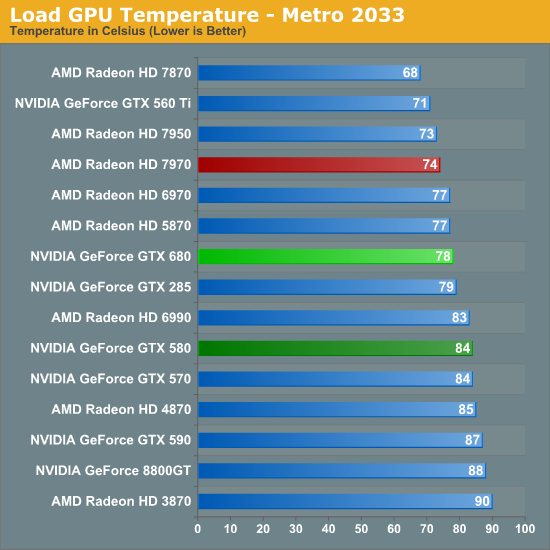
As for load temperatures, we’re once more in a familiar situation regarding NVIDIA and AMD design strategies. AMD’s aggressive cooling strategy keeps their 7900 cards in the mid-to-low 70s, while NVIDIA favors slightly higher temperatures for what we’ll see translates into less noise. At 78C under Metro NVIDIA is not repeating the common 80C+ temperatures the GTX 570 and GTX 580 reach, which is a reflection of the smaller GPU and smaller manufacturing process. NVIDIA’s max operating temperature for the GTX is 98C, so we have a good 20C to play with when it comes to overclocking.
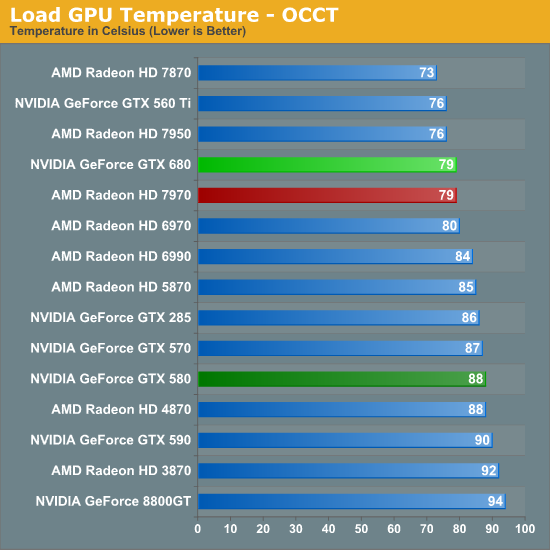
Switching over to OCCT, we suddenly find ourselves in an interesting situation when NVIDIA and AMD become relatively equalized. At 79C both the 7970 and GTX 680 are running at the same temperature, an unexpected situation given the latter’s lack of a throttling mechanism for OCCT. Once again it also drives a large gap between the GTX 680 and GTX 580, having reduced temperatures by 9C. And at the same time temperatures are up only 3C compared to the GTX 560 Ti, even with its lower power consumption and open air cooler. However if and when Big Kepler does come, I would expect GTX 580-like temperatures to return.
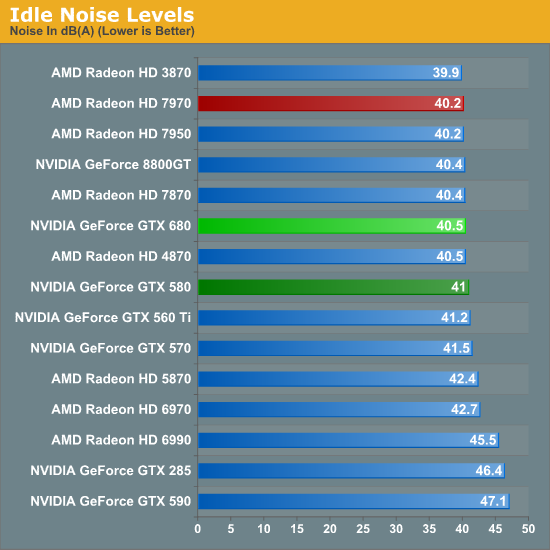
Last but not least we have our look at noise, which is typically the most important of the 3 physical attributes of a video card. Like idle temps, idle noise is largely a solved problem, which is why all of our results cluster around 40dB. The GTX 680 is 0.5dB quieter than the GTX 580 and 0.3dB louder than the 7970, but at this range the difference is nearly academic as noise from other system components is the biggest contributing factor.
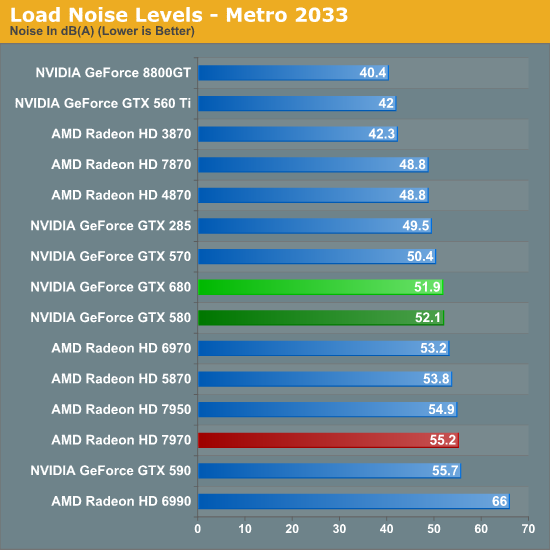
Now how does the GTX 680 fare in load noise? The answer depends on what you want to compare it to. Compared to the GTX 580, the GTX 680 is practically tied – no better and no worse – which reflects NVIDIA’s continued use of a conservative cooling strategy that favors noise over temperatures. At the same time, compared to the GTX 560 Ti this is a massive increase in noise, with just shy of a 10dB jump. The difference comes down to a few things, the most important of which is that the GTX 680 has a closed blower instead of the GTX 560 Ti’s unusually impressive open air cooler. At the same time as we’ve seen power consumption is up versus the GTX 560 Ti, so maintaining 42dB wouldn’t have been very practical even with another open air cooler.
Finally we have the Radeon comparison, where NVIDIA does quite well. AMD’s aggressive cooling strategy combined with the higher power consumption of the 7970 means that the 7970 is on the wrong side of the GTX 680 here, with the GTX 680 generating 3.3dB less noise. So while NVIDIA failed to significantly improve on the GTX 580 they did beat out AMD, which is going to be the more important difference for most buyers. All things considered I’m wondering if NVIDIA still couldn’t have done better here, but I think the limiting factor here is that NVIDIA doesn’t have a whole ventilation slot to work with.

Last, but not least, we have our look at OCCT noise. Even with a lack of throttling, the smaller range between NVIDIA’s typical and max power consumption thanks to GPU Boost – and thereby a smaller range between their typical and max heat generation – has kept both their temperatures and noise in check when moving from Metro to OCCT. NVIDIA has effectively extended their lead here, with a 4.8dB gap between the GTX 680 and the 7970, and an even larger 6.8dB gap between the GTX 680 and the GTX 580. The only real loss here is against the GTX 560 Ti, which like we saw with Metro, is simply well ahead of anything else due to its open air cooler.
Of course NVIDIA has one of the lowest power consuming video cards with a closed blower, which means they are already starting these noise tests with a favorable position. The only contemporary blower to best the GTX 580 is the 7870, and even that is only by 0.6dB.
Wrapping things up here, all things considered NVIDIA does seem to have a good job reaching balance with temperature and noise here. Their lower power consumption keeps them more than competitive with the Radeon HD 7900 series and GTX 570/580 right off the bat, and combined with their balanced cooler we’re seeing temperatures that are not too hot, and noise levels that are not too loud. There’s no doubt someone is going to try to best the reference GTX 680 in the future with a dual fan open air cooler though, so it will be interesting to see if it will be possible to improve on the GTX 680 by giving up direct cooling efficiency for lower noise levels.










404 Comments
View All Comments
Targon - Thursday, March 22, 2012 - link
Many people have been blasting AMD for price vs performance in the GPU arena in the current round of fighting. The thing is, until now, AMD had no competition, so it was expected that the price would remain high until NVIDIA released their new generation. So, expect lower prices from AMD to be released in the next week.You also fail to realize that with a 3 month lead, AMD is that much closer to the refresh parts being released that will beat NVIDIA for price vs. performance. Power draw may still be higher from the refresh parts, but that will be addressed for the next generation.
Now, you and others have been claiming that NVIDIA is somehow blowing AMD out of the water in terms of performance, and that is NOT the case. Yes, the 680 is faster, but isn't so much faster that AMD couldn't EASILY counter with a refresh part that catches up or beats the 680 NEXT WEEK. The 7000 series has a LOT of overclocking room there.
So, keep things in perspective. A 3 percent performance difference isn't enough to say that one is so much better than the other. It also remains to be seen how quickly the new NVIDIA parts will be made available.
SlyNine - Thursday, March 22, 2012 - link
I still blast them, I'm not happy with the price/performance increase of this generation at all.Unspoken Thought - Thursday, March 22, 2012 - link
Finally! Logic! But it still falls on deaf ears. We finally see both sides getting their act together to get minimum features sets in, and we can't see passed our own bias squabbles.How about we continue to push these manufactures in what we want and need most; more features, better algorithms, and last and most important, revolutionize and find new way to render, aside from vector based rendering.
Lets start incorporating high level mathematics for fluid dynamics and the such. They have already absorbed PhysX and moved to Direct Compute. Lets see more realism in games!
Where is the Technological Singularity when you need one.
CeriseCogburn - Thursday, March 22, 2012 - link
Well, the perspective I have is amd had a really lousy (without drivers) and short 2.5 months when the GTX580 wasn't single core king w GTX590 dual core king and the latter still is and the former has been replaced by the GTX680.So right now Nvidia is the asbolute king, and before now save that very small time period Nvidia was core king for what with the 580 .. 1.5 years ?
That perspective is plain fact.
FACTS- just stating those facts makes things very clear.
We already have heard the Nvidia monster die is afoot - that came out with "all the other lies" that turned out to be true...
I don't fail to realize anything - I just have a clear mind about what has happened.
I certainly hope AMD has a new better core slapped down very soon, a month would be great.
Until AMD is really winning, it's LOSING man, it's LOSING!
CeriseCogburn - Thursday, March 22, 2012 - link
Since amd had no competition for 2.5 months and that excuses it's $569.99 price, then certainly the $500 price on the GTX580 that had no competition for a full year and a half was not an Nvidia fault, right ? Because you're a fair person and "finally logic!" is what another poster supported you with...So thanks for saying the GTX580 was never priced too high because it has no competition for 1.5 years.
Unspoken Thought - Saturday, March 24, 2012 - link
Honestly the only thing I was supporting was the fact he is showing that perspective changes everything. a fact exacerbated when bickering over marginal differences that are driven by the economy when dealing with price vs performance.Both of you have valid arguments, but it sounds like you just want to feel better about supporting nVidia.
You should be able to see how AMD achieved its goals with nVidia following along playing leap frog. Looking at benchmarks, no it doesn't beat it in everything and both are very closely matched in power consumption, heat, and noise. Features are where nVidia shine and get my praise. but I would not fault you if you had either card.
CeriseCogburn - Friday, April 6, 2012 - link
Ok Targon, now we know TiN put the 1.3V core on the 680 and it OC'ed on air to 1,420 core, surpassing every 7970 1.3V core overclock out there.Furthermore, Zotac has put out the 2,000Ghz 680 edition...
So it appears the truth comes down to the GTX680 has more left in the core than the 7970.
Nice try but no cigar !
Nice spin but amd does not win !
Nice prediction, but it was wrong.
SlyNine - Thursday, March 22, 2012 - link
Go back and look at the benchmarks idiot. 7970 wins in some situations.SlyNine - Thursday, March 22, 2012 - link
In Crysis max, 7970 gets 36 FPS while the 680 only gets 30 FPS.Yes, some how the 7970 is losing. LOOK AT THE NUMBERS, HELLO!!???
Metro 2033 the 7970 gets 38 and the 680 gets 37. But yet in your eyes another loss for the 7970...
7970 kills it in certian GPU Compute, and has hardware H.264 encoding.
In a couple of games, which you already get massive FPS with both, the 680 boasts much much higher FPS. But than in games where you need the FPS the 7970 wins. Hmmm
But no no, you're right, the 680 is total elite top shit.
eddieroolz - Friday, March 23, 2012 - link
You pretty much admitted that 7970 loses in a lot of other cases by stating that:"7970 kills it in certain GPU compute..."
Adding the word modifier "certain" to describe a win is like admitting defeat in every other compute situation.
Even for the games, you can only mention 2 out of what, 6 games where 7970 wins by a <10% margin. Meanwhile, GTX 680 proceeds to maul the 7970 by >15% in at least 2 of the games.
Yes, 7970 is full of win, indeed! /s